Grower-funded research projects
Plant establishment
Investigating wider row spacing in no-till canola: Implications for weed competition, response to
nitrogen fertilizer and seeding rate recommendations
Principal investigator: Chris Holzapfel, Indian Head Agricultural Research Foundation
Funding: SaskCanola
Purpose: In response to interest among canola growers and equipment manufacturers, a project was initiated in 2012 at Indian Head, Sask., to evaluate canola performance at row spacing up to 61cm. Three separate field trials were designed to evaluate row-spacing implications for side-banded nitrogen (N), seeding rate recommendations and crop competition with weeds.
Progress: Despite high weed pressure, a single in-crop herbicide application kept weed competition acceptably low at all row spacing levels. Increasing row spacing resulted in slight but significant delays in maturity, but delays caused by row spacing were usually much smaller than those caused by nitrogen (N) fertilizer or seeding rate. Results to date suggest that N requirements of canola are likely similar regardless of row spacing, particularly for the range of 25-41 cm. Data from 2016 was not available at printing, but data from previous years showed minimal or no yield loss at wider spacing.
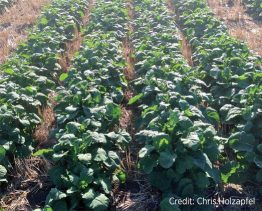
Developing canola agronomy with precision planters
Principal investigator: Ken Coles, Farming Smarter
Funding: ACPC, MCGA, Farming Smarter
Purpose: Precision planters provide superior depth control and seed distribution over conventional seeders, and thus have the potential to improve the proportion, uniformity and rapidity of canola emergence. This study hopes to explore optimum row spacing and seed-safe rates with in-row liquid phosphorus fertilizer.
Progress: Six trials were planted in southern Alberta in 2016. All trials have been harvested but analysis of data was not complete at the time of printing.
To germinate or not to germinate? Towards understanding the role dormancy plays in canola seed vigour, seedling vigour and stand establishment
Principal investigator: Sally Vail, AAFC Saskatoon
Funding: CARP, AIP
Purpose: This project is investigating the inter-relatedness of the potential for different forms of dormancy, seed biology characteristics and seedling vigour traits across a diversity panel of Brassica napus lines. It will also investigate the effect of maternal environment and source seed processing on enhancing or diminishing dormancy potential of canola seed. Results will guide plant breeding to ultimately reduce the secondary or inducible dormancy potential of canola.
Progress: A wide range of secondary dormancy potential has been identified across the lines harvested in 2015. The role environment plays in primary and secondary dormancy potential is being explored with seed produced in two contra-season environments and from the 2016 field season. Additionally, characterization of lines for propensity to precociously germinate within the ripening pod is ongoing and values will be compared to dormancy potential values. Seed vigour metrics for lines and seedlots will be explored over the next year and all values will be compared to both established (eg. oil, protein, fiber, glucosinolate and fatty acid profiles) and novel seed quality traits (eg. protein fractions). Researchers are also working with hybrid seed production partners to design a strategy to survey secondary dormancy
potential within current commercial seedlots.
Fertility management
Crop response to foliar-applied phosphorus fertilizers
Principal investigator: Jeff Schoenau, University of Saskatchewan
Funding: SaskCanola, ADF, SPG, SWDC
Purpose: To determine the effect of foliar-applied phosphorus (P) on crop (canola, wheat, pea) response and residual soil phosphorus fertility in comparison to soil-applied phosphorus.
Progress: The study began in spring of 2016 with four field-research sites selected across the Brown, Dark Brown and Black soil zones of Saskatchewan. Different treatments of foliar-applied orthophosphate solution were applied mid-season to canola, wheat and peas. Some treatments were in combination with granular monoammonium phosphate (11-52-0) applied with the seed. Plant samples were obtained for analysis before and after foliar P application. Harvest samples were analyzed for yield and contents of total P, phytate, zinc and iron to determine crop recovery of P and the impact of the treatments on the nutritional quality of the grain. Soil samples were taken after harvest and analyzed for available P forms. Soil was also collected in fall of 2016 from sites for controlled environment studies to evaluate the effect of different foliar P forms and rates on the crop P nutrition and the fate of the P in soil and run-off water. Field trials will be repeated again in 2017.
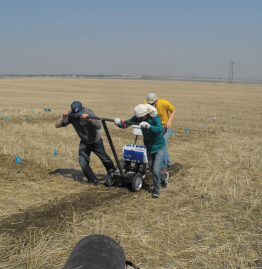
Enhancing canola production with improved phosphorus fertilizer management
Principal investigator: Stewart Brandt, Northeast Agriculture Research Foundation
Funding: SaskCanola
Purpose: This research investigates whether current phosphorus (P) fertilizer recommendations are adequate for high-yielding cultivars and if all fertilizer P needs to be seed placed. It also examines if current recommendations regarding safe rates of P and sulphur (S) are suitable for typical knife or hoe openers in use today.
Progress: In 2016, trials were conducted at three sites in Saskatchewan (Melfort, Scott and Indian Head). Results are being compiled as yield data is available and the annual report will be submitted in early 2017.
Enhanced Saskatchewan soil data for sustainable land management
Principal investigator: Angela Bedard-Haughn, University of Saskatchewan
Funding: SaskCanola, SaskPulse, ADF
Purpose: This project aims to provide improved access to Saskatchewan soil information, both desktop and mobile. In addition, it will explore ways to enhance and utilize this soil information, including digital soil mapping at a resolution and scale useful for precision management and applications that allow producers to upload and integrate their own field-scale data to inform nutrient management decisions.
Progress: As of October, an early prototype of the soil information storage and access framework is in place, including the web interface for accessing and querying information. As harvest wraps up, researchers are collecting information from test sites to begin work on refined soil maps using digital soil mapping techniques.
Identifying the mechanisms responsible for greater than expected residue-induced N2O emissions from canola and flax
Principal investigator: Richard Farrell, University of Saskatchewan
Funding: SaskCanola, ADF
Purpose: Previous research found a higher potential for nitrous oxide (N2O) emissions from decomposing canola (and flax) residues compared to wheat or pea residues. This project aims to identify the reasons for this and provide guidance for future studies to develop and test strategies to minimize N2O emissions from oilseed residues and retain more residue-derived N in the soil for subsequent crop growth.
Progress: Year 1 involved isotopically labeling the test crops (canola, flax, pea and wheat) with 15N and 13C by growing the crops under controlled conditions in a greenhouse. At maturity, the plants were harvested and the seed, above-ground residue, and below-ground residue (roots) were separated, weighed, dried and analyzed. Biochemical and isotopic characterization of the different crop residues is currently underway.
Enhancing the beneficial root microbiome in canola
Principal investigator: Chantal Hamel, AAFC
Funding: SaskCanola, Alberta Canola, MCGA, NSERC
Purpose: This project aims to validate a list of the reliable microbial associates always present and abundant in the canola root microbiome, while determining crop rotations that favour the establishment of a beneficial root microbiome in canola-based rotations.
Progress: Two field experiments were planted and sampled in 2016. At Indian Head, Sask., plots were sampled at the vegetative and full-bloom stages from three cropping systems. In Swift Current, Sask., samples were taken at full bloom from three levels of previous crop that will be followed by five different Brassica crops, including B. napus. DNA is being analyzed to describe crop root and rhizosphere microbiomes. The beneficial nature of the microorganisms is being determined based on identity and abundance of important functional genes, as well as on crop performance.
Integrated Pest Management
Can harvest weed seed management be used to control kochia, cleavers and wild buckwheat?
Principal investigator: Steve Shirtliffe, University of Saskatchewan
Funding: SaskCanola
Purpose: The study has two main objectives: (1) To determine the timing of seed shed in kochia, cleavers and wild buckwheat to determine whether their seed dispersal can be managed effectively at harvest. (2) To see if pre-harvest herbicide can reduce viable seed production in these three weeds.
Progress: The project is in its final year and results are promising. Kochia, wild buckwheat and cleavers retained on average 98, 90, and 91 per cent of their seeds at harvest, respectively. This indicates high potential for weed seed removal from the field with a timely harvest. Viability testing is currently underway to determine the efficacy of pre-harvest herbicide application in reducing weed seed survival.
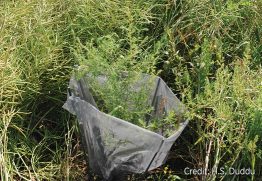
Assessing the influence of base germination temperature and chemical desiccants on the recruitment biology of cleavers
Principal investigator: Chris Willenborg, University of Saskatchewan
Funding: SaskCanola
Purpose: This project aims to determine the base germination temperature of several cleavers populations in Western Canada and determine the influence of chemical desiccants on cleavers seed properties.
Progress: The first year of desiccant field trials were completed and data has yet to be analyzed. The base germination temperature experiment is currently underway and will be completed in December 2016.
Validation of lygus and other insect pest thresholds in commercial farms throughout Alberta
Principal investigator: Hector Carcamo, AAFC Lethbridge
Funding: Alberta Canola, SaskCanola
Purpose: The primary objective is to validate lygus threshold derived from cages in commercial canola fields. Secondary objectives are to assess insecticide sprays for other pests such as flea beetles or cabbage seedpod weevil on canola yield and relate landscape features to lygus distribution.
Progress: Lygus were very scarce throughout the Prairies and Peace River region in 2016. The study was completed at two sites near Claresholm in southern Alberta. One farm was sprayed for flea beetles in southern Manitoba. The study has been extended for another three years to include more fields in the three Prairie Provinces.
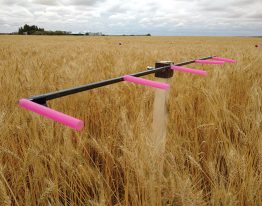
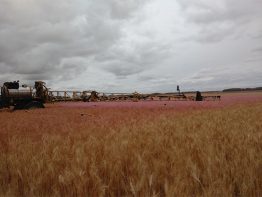
Characterizing turbulent spray deposition from self-propelled sprayers
Principal investigator: Tom Wolf, AgriMetrix
Funding: Alberta Canola, SaskCanola
Purpose: This study will measure the spray deposit at 30 points along the boom to understand how travel speed, boom beight and nozzle choice affect the amount received by the crop and also how variable that deposit is. A more variable deposit means that some parts get too much and others too little, which can affect overall spray performance.
Progress: The first study was done late in 2016
growing season and results were not available at the time of printing.
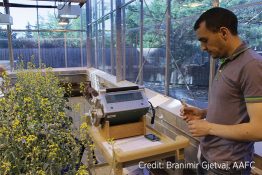
Impact of drought and heat during flowering on canola yield
Principal investigator: Raju Soolanayakanahally, AAFC Saskatoon
Funding: SaskCanola, ADF, AAFC
Purpose: Changing precipitation and temperature patterns will cause significant yield losses if drought and heat waves become more common. The project evaluates spring canola lines for drought, heat and combined stresses in greenhouse and field conditions. The study employs physiological approaches to identify donor parents for stress-tolerance breeding.
Progress: Work is in progress to screen diverse spring canola lines under controlled greenhouse conditions at AAFC to better understand stress response on flowering and yield.
Toxicopathological determination of safe dose ranges of neonicotinoids for honey bee colonies
Principal investigator: Elemir Simko, Western College of Veterinary Medicine (WCVM), University of Saskatchewan
Funding: SaskCanola, WGRF, Saskatchewan Beekeepers Development Commission, Canadian Honey Council, North American Pollinator Protection Campaign
Purpose: The ‘gold standard’ mammalian safety toxicopathological tests are very sensitive and veterinary pathologists use them to detect sublethal toxic effects of candidate drugs, pesticides and other chemicals in laboratory animals in order to determine the safe dose range. Comparable approaches have not been developed for honey bees. WVCM has the expertise and research capacity to adopt this mammalian ‘gold standard’ safety evaluation to honey bees and to determine the safe dose range for the three most commonly used neonicotinoids in agriculture.
Progress: Adaptation of mammalian safety histopathology tests to honey bees has begun. Researchers are assembling databases of normal histology of larvae, pupae and adults of honey bee workers, drones and queens that will be used for subsequent testing.

Credit: Shelley Hoover
Pollination management to maximize canola yield
Principal investigators: Shelley Hoover, AF, Steve Pernal, AAFC Beaverlodge, Ralph Cartar University of Calgary
Funding: Alberta Beekeepers Commission, ASCA, ACIDF, CCC
Purpose: This project is to quantify the contribution of managed pollinators to canola yield, and to provide management guidelines to maximize both pollination and bee health.
Progress: Year 3 of 3. Insect visitation of commodity canola flowers tends to decrease with depth into a field, whereas the volume of nectar available to pollinators tends to increase with distance from the field edge.
Researchers are currently processing canola plants and pods to correlate yield metrics with bee abundance. Experimental data on pollen collection from summer 2016 will be used to compare the economics of pollen versus honey collection by beekeepers whose colonies are rented out to pollinate hybrid canola seed production fields. Observations in hybrid seed fields indicate numerous behavioural interactions within and among pollinator species. Female leafcutter bees transfer the most pollen to previously unvisited flowers. Leafcutter bees are also more likely to switch from a male to a female plant when foraging, thereby increasing the likelihood of transferring pollen.
Getting more bang for your buzz: does pollination compensate for canola yield loss under sub-optimal moisture, nitrogen fertilization, and/or seeding rate?
Principal investigators: Ralph Cartar, University of Calgary; Shelley Hoover, AF Lethbridge; Steve Pernal, AAFC Beaverlodge; Neil Harker, AAFC Lacombe; Andony Melathopoulos, Oregon State University
Funding: Alberta Canola, Alberta Beekeepers Commission
Purpose: This study will test if pollination can compensate for canola yield loss under sub-optimal moisture, nitrogen fertilization and/or seeding rate.
Progress: Year 1 of 3. Greenhouse trials will start this fall at AAFC Lethbridge. The team has agreements with multiple seed companies, and has acquired the 25 varieties of canola seed to get started. Further experiments will start in spring 2017 in Beaverlodge.
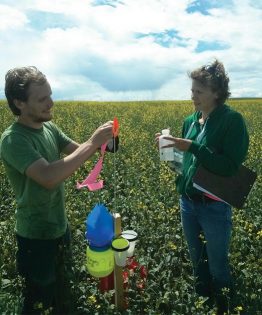
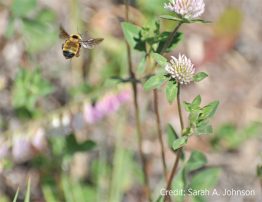
Surveillance networks for beneficial insects: Can natural habitats serve as insect reservoirs, and do they contribute to canola yield?
Principal investigator: Paul Galpern, University of Calgary
Funding: SaskCanola, Alberta Canola, MCGA, CCC
Purpose: This project will examine the relationship
between the diversity and abundance of beneficial insects and canola production in Western Canada. Specifically, it will address the role of natural habitats near canola fields as reservoirs for pollinators and natural enemies of canola pests as well as the capacity of these beneficial insects to increase seed yield through pollination and pest reduction.
Progress: Data collection on the diversity and abundance of pollinators near canola fields began in 2016, as did a pilot study to collect and identify natural enemies. The first meeting of the Prairie Beneficial Insect Working Group, an advisory group of academic and government researchers as well as representatives from the Canola Council of Canada, has been scheduled for November. Qualified personnel will identify insect specimens and analyze canola yield and insect diversity data.
Enhanced modelling of swede midge population dynamics in North America
Principal investigator: Rebecca Hallett, University of Guelph
Funding: SaskCanola, Alberta Canola
Purpose: The aim is to develop a complete population dynamics model for swede midge. The model will be used to explore differences among North American populations of swede midge and will try to predict the lag time between first detection in an area and subsequent occurrence of economically damaging populations.
Progress: A new graduate student started in September and is training on the modelling software. Evaluation of an older model that only predicted adult emergence of swede midge will identify weaknesses that need improvement. Collection of literature to support the addition of new life history information to the model is nearly complete. Feasibility of the model to assess
the time from detection to economic damage is being assessed.
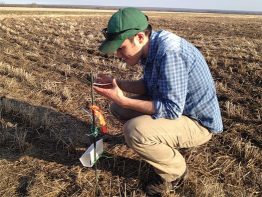
Ecology of swede midge –host plant interactions
Principal investigators: Boyd Mori, Owen Olfert, Julie Soroka, AAFC Saskatoon
Funding: ADF, WGRF, SaskCanola
Purpose: Year 1 of 4. The purpose is to investigate host plant susceptibility or resistance factors to swede midge, with the ultimate aim of identifying host plant resistance.
Progress: Researchers are currently growing plants from a collection of plant species known to be swede midge hosts or non-hosts, creating a colony of swede midge for laboratory bioassays, and developing bioassay techniques to start experiments on midge-plant interactions.
Development and implementation of a weather-based, near real-time, crop insect pest monitoring/prediction model and program for Alberta
Principal investigator: Daniel Itenfisu, AF
Funding: Alberta Canola, AF
Purpose: The aim is to develop and implement a provincial weather-based, near real-time (NRT) insect pest prediction model as a web-based risk management tool for three significant insect pests: bertha armyworm, alfalfa weevil and wheat midge. The models will provide a timely prediction of the pests and assist in devising effective pest management practices.
Progress: Year 2 of 3. The final field season concluded with data collection on phenology (seasonal cycles) and life history of three pests and their natural enemies along with crop phenology monitoring across 26 sites in Alberta. Pest phenological monitoring procedures included yellow sticky traps for wheat midge females and parasitoids, spring soil sampling to predict midge emergence and scouting for second-generation alfalfa weevil adults. Quality control and analysis on collected field data leading to improved phenology models for each species is currently underway.
Coordinated surveillance, forecasting and risk warning systems for field crop insect pests of the Prairie ecosystem
Principal investigator: Owen Olfert, AAFC Saskatoon
Funding: Alberta Canola, SaskCanola, MCGA, WGRF
Purpose: The aim is to develop and implement insect surveillance programs to identify risks to crop production from pest species and to highlight and conserve their natural enemies.
Progress: Year 3 of 5. Data from annual surveys in 2016 provided a snapshot of current pest status and reflected the future risks to varying degrees.
Provincial and industry collaborators, together with project team members, monitored over 4,000 sites for grasshoppers, 700 for wheat midge, 800 for cabbage seedpod weevil, 500 for bertha armyworm, 200 for pea leaf weevil and 95 for wheat stem sawfly. In addition, sentinel sites were monitored for flea beetles, cutworms, swede midge and cereal leaf beetle. Weekly updates were provided using the Prairie Pest Monitoring Network blog.
Verticillium longisporum in Manitoba: Understanding the pathogen and establishing surveillance capacity.
Principal investigator: Mario Tenuta, University of Manitoba
Funding: MCGA, Richardson International,
MB Grain Hub, GF2 and WGRF.
Progress: The farm found to have V. longisporum was sampled. Hundreds of other samples were also collected for quantification of V. longisporum at the Pest Surveillance Laboratory (PSI) in Winnipeg. Training of PSI personnel in the extraction protocol has begun.
Design and testing an in-field real-time nano-sensor device for pathogen monitoring in canola
Principal investigator: Xiujie Li, Alberta Innovates – Technology Futures
Funding: ACIDF, Alberta Canola, AITF
Purpose: The long-term goal is to develop an in-field sensor for the detection of plant disease pathogen levels and transfer results to an electronic device in a real-time fashion. The purpose of this project is to design and make the device, and test it in the greenhouse and in
the field.
Progress: A Sclerotinia sclerotiorum ascospore trap has been selected and spore trapping under greenhouse conditions was successful. An electrode nano-chip to detect spores has also been designed and tested. Current work is putting these two together and testing the device in a greenhouse.
Analysis and monitoring of Leptosphaeria maculans race dynamics in Western Canada for effective use of cultivar resistance in management of blackleg on canola
Principal investigator: Gary Peng, AAFC Saskatoon
Funding: SaskCanola, Alberta Canola, MCGA, WGRF, ACIDF, ARDI and seed companies.
Purpose: To analyze and monitor the blackleg pathogen population using Westar trap plots scattered on the Prairies. This will provide industry with up-to-date pictures of L. maculans race structure, as well as the pathogen race dynamics to guide cultivar selection and rotation. Selected fields with different blackleg severity will be investigated to understand the role of L. maculans race changes in causing the cultivar to lose the resistance.
Progress: A total of 334 L. maculans isolates from the 17 Westar trap plots across the Prairies were tested using a differential set of Brassica lines for Avr profile. Results showed that AvrLm1, AvrLm3, AvrLm9, AvrLep1 and AvrLep2 were either very low or undetectable in the pathogen population while AvrLm2, AvrLm4, AvrLm6 and AvrLm7 were found in more than 50 per cent of isolates. However, AvrLm4 in Alberta remained lower (20-40 per cent) than in other provinces, and AvrLm2 and AvrLm6 were noticeably lower than in 2015 in Manitoba. This information can help the selection of specific R genes for blackleg resistance breeding.
Understanding the mechanisms for race-specific and non-specific resistance for effective use of cultivar resistance against blackleg of canola in Western Canada
Principal investigator: Gary Peng, AAFC Saskatoon
Funding: GF2, CARP
Purpose: This study aims to characterize blackleg resistance used in western Canada, and assess potential influence of environmental factors, especially hot, dry conditions, on the expression of resistance to better understand the mechanisms of different types of resistance.
Progress: Race non-specific resistance was assessed with eight selected commercial canola cultivars (CCCs) from four major seed companies supplying to the majority of canola acres in western Canada. These cultivars carry only the R genes Rlm1 and/or Rlm3. Three of the CCCs with slightly different levels of resistance on cotyledon were assessed further using cotyledon and petiole inoculation, respectively, as well as the droplet digital PCR (ddPCR) and GFP-labelled fluorescent microscopy. Results showed that the spread of pathogen into the stem was more limited on CCCs than on Westar and the infection developed more slowly in the stem of CCCs. It appears that many Canadian CCCs carry non-specific blackleg resistance, while the common R genes Rlm1 and Rlm3 are no longer
effective in most regions of western Canada.
Characterization of the new strains of the clubroot pathogen in Alberta
Principal investigators: Sheau-Fang Hwang, AF, Stephen Strelkov, University of Alberta
Funding: ACIDF, WGRF, Alberta Canola, SaskCanola
Purpose: Objectives are to monitor spread of novel clubroot strains through surveys, assess the potential of novel pathotypes to reappear, characterize the pathotypes of clubroot that appear where resistance has broken down and multiply inoculum of novel pathotype(s) for resistance screening.
Progress: Pathogen strains capable of overcoming clubroot resistance have been identified in 42 fields. These fields are located mainly in central Alberta but with isolated cases found up to about 600 km apart. Eleven distinct strains have been identified, based on their virulence on a putative Canadian Clubroot Differential Set. Strains collected in 2016 will be characterized over the fall and winter under controlled conditions.
Toward a strategy for reducing the spore density and dissemination of clubroot of canola in Alberta
Principal investigator: Sheau-Fang Hwang, AF
Funding: Alberta Canola, ACIDF, WGRF
Purpose: The aim is to develop a better understanding of the distribution and dispersal of clubroot and to develop methods to eradicate or reduce newly established infestations within fields and on a regional basis.
Progress: Application rates of Vapam fumigant had a significant effect on canola stand establishment, plant height, pod number, seed yield and disease severity at both field sites. Disease severity and gall weight decreased as the Vapam rates increased. However, it should be noted that Vapam is a non-selective toxin. It is both volatile and highly soluble in water and as such constitutes a hazard to human health, as well as to non-target organisms in the area surrounding its application. Applicators must follow all regulations regarding its use and adhere to the label recommendations.
Development of canola cultivar blackleg resistance groups: feasibility evaluation
Principal investigator: Ralph Lange, Alberta Innovates
Funding: Alberta Canola, WGRF, ACIDF
Purpose: The objective is to determine if Canadian canola cultivars can be organized into resistance groups that would allow producers to choose cultivars with different blackleg resistance genes from those previously seeded.
Progress: Initial testing of a small set of commercial cultivars showed that cultivars appeared to divide into two groups on the basis of presence of the Rlm3 resistance gene. On the basis of this preliminary grouping, researchers identified fields in Alberta where the seeded cultivar was known and compared field and controlled-environment performance against blackleg. These data further supported a resistance group model with two cultivar groups. Next, they evaluated cultivars against field-collected residues from a wider range of collection locations. They also applied a new testing technique that corrects for different levels of inoculum in different residue samples and also allows seedlings and rosette-stage plants to be inoculated. When looking at wound-inoculated cotyledons, they found that all cultivars were equally, and highly susceptible to blackleg. This was true regardless of the source of the L. maculans population. When cotyledon-inoculated plants were allowed to reach maturity, or when plants were spray-inoculated, differences among cultivars and variability among locations were observed. Researchers will complete analysis of results before making any revisions to the putative resistance groups.
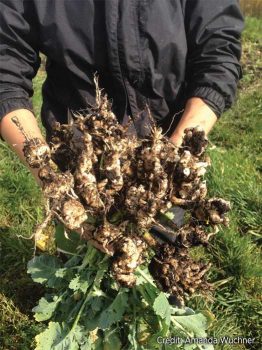
Supporting continued development of clubroot-resistant canola and early detection of clubroot outbreaks.
Principal investigator: Michael Harding, AF
Funding: Alberta Canola, WGRF, ACIDF
Purpose: The objectives are to evaluate canola lines and cultivars for their various levels of resistance to P. brassicae (pathotype 5) and evaluate the efficacy of soil amendments and treatments for clubroot management. Additionally, the project enhances clubroot surveillance in southern Alberta in attempts to rapidly identify any new introductions or outbreaks of clubroot south of Highway 1.
Progress: Year 4 of 4. Since 2013, dozens of new lines/cultivars have been screened for resistance at this disease nursery and a number of them have shown strong resistance to pathotype 5. Soil amendments and chemical fumigants have demonstrated limited ability to provide significant or consistent control of clubroot in areas with high resting-spore populations. Clubroot surveillance has not discovered any new infestations south of Highway 1.
Improving sclerotinia disease control in edible beans and canola
Principal investigator: Michael Harding, AF
Funding: Alberta Canola, WGRF, APG
Purpose: The objectives were to look for synergistic relationships between foliar-applied micronutrients and fungicides when tank mixed, and to evaluate the efficacies of “resistance-priming” chemicals as seed treatments to improve sclerotinia management.
Progress: Year 4 of 4. A few synergistic combinations appeared in some years, however none of the tank-mixed treatments were consistent in all years tested. One of the resistance-priming chemicals applied to seed has shown significant white mould reduction in two of three years in dry bean but none of these compounds have shown any significant effect on stem rot in canola. Dry conditions in 2015 resulted in very little sclerotinia disease pressure, making it difficult to evaluate these seed and foliar-applied treatments, but 2016 provided ideal conditions for sclerotinia development. Results from 2016 and a final report for the project will be submitted in 2017.
Harvest Management
Determining best practices for summer storage of canola
Principal investigator: Joy Agnew, PAMI
Funding: SaskCanola, MCGA
Purpose: The aim is to determine if aeration or turning of canola in the spring results in more stable storage conditions throughout the summer than leaving it alone. Data collected in 2016 was used to validate results collected in 2014.
Progress: In 2016, three 4,000-bu bins were continuously monitored, beginning on June 2 and wrapping up on August 19. One bin was left alone, one bin was aerated in mid-June and one bin was turned on June 2. The
average moisture content of the stored canola was nine per cent (compared to the 6.5 per cent canola monitored in 2014). Results indicated that no significant condensation or moisture migration occurred in any of the bins, but the baseline (control) bin had the most stable conditions throughout the summer and the coolest core (4°C) at the end of the monitoring period.
Canola Direct-Cut Harvest Systems
Principal investigator: Nathan Gregg, PAMI
Funding: SaskCanola, ADF, WGRF, PAMI
Purpose: The purpose is to compare yield, seed quality, header shatter loss and environmental shatter loss for draper, rigid and extendable cutterbar headers as well as a swath-based system. The three-year study has
three test locations: Indian Head, Swift Current and Humboldt.
Progress: Year 3 of 3. The first two years of data indicate a slight loss-reduction advantage with the extendable cutterbar header relative to other direct-cut headers tested, and marginal differences in yield, feeding, ground following and ease of operation. Other factors in loss, which include variety, field selection and crop condition, have shown a significant impact on header
performance. Seed losses attributable to active knife dividers (rotary and vertical knives) were also compared to standard fixed dividers. These and other header-related comparisons continued through the fall of 2016, and full results will be released in early spring 2017.

Genetics
Identification and genetic mapping of Brassica napus for resistance to pathotype 5x of Plasmodiophora brassicae
Principal investigator: Fengqun Yu, AAFC Saskatoon
Funding: CARP, AAFC
Purpose: Year 2 of 4. The project aims to identify new sources of B. napus for resistance to pathotype 5x, map clubroot resistance (CR) genes and develop markers tightly linked to the genes for use in marker-assisted reeding. It will then work to facilitate the rapid incorporation of multiple CR genes into elite canola breeding lines.
Progress: A total of 845 B. napus lines were tested for resistance to pathotype 5x. Thirty-one lines with a disease severity index of less than 20 per cent were obtained. A set of 189 lines were sequenced using next generation sequencing technology. Markers are being analyzed to understand the population structure and find sections of DNA associated with resistance
to clubroot.
Developing near-isogenic Brassica napus lines for differentiating pathotypes of Plasmodiophora brassicae
Principal investigator: Fengqun Yu, AAFC Saskatoon
Funding: WGRF, ADF, SaskCanola
Purpose: Year 3 of 4. This project aims to develop B. napus lines each with a single unique clubroot resistance gene from Brassica vegetable species. These lines could be used for differentiating pathotypes of P. brassicae and rapid incorporation into canola variety development programs.
Progress: Researchers have obtained BC2, BC3 and BC4 introgressed B. napus lines containing eight single clubroot resistance genes.
Molecular cytogenics of blackleg resistance in the Brassica B-genome and introgression of resistance into B. napus through recurrent backcrossing
Principal investigator: Habibur Rahman, University of Alberta
Funding: ACIDF, Alberta Canola
Purpose: The aim is to identify, using molecular cytogenetic study, the B-genome chromosomes of Brassica carinata carrying cotyledon and adult plant resistance to blackleg PG4-type isolate. The purpose is to identify resistance for introgression into B. napus.
Progress: Research has identified one B-genome chromosome of B. carinata carrying resistance to a PG2-type isolate. However, this resistance gene alone does not confer resistance to the more virulent isolates, despite B. carinata showing resistance to these isolates. This indicates that more than one gene in B. carinata may be involved in the control of resistance to these isolates. Identification of additional genes in B. carinata for introgression into B. napus is in progress.

Comparative genomics of apomictic plants: advancing novel tools for niche breeding
Principal investigator: Tim Sharbel, Global Institute for Food Security
Funding: SaskCanola, ADF, CGDP, GIFS
Purpose: The aim is to generate a high-quality genome of Boechera, a wild Brassicaceae that can reproduce apomictically. Apomictic plants produce seeds without pollen (male) fertilization, and thus all offspring are genetic clones of the mother. The ability to introduce apomixis into canola would enable single generation hybrids to be produced and fixed genetically, regardless of the genetic complexity behind the phenotypic traits of interest. This could provide the opportunity to produce more genetically-variable canola lines with ease, thereby enabling breeders to exploit niche breeding
and rapidly breed varieties adapted to changing environmental conditions.
Progress: Researchers have submitted high-quality DNA to NRGene for genome sequencing and assembly. They are micro-dissecting developing ovules from different apomictic genotypes for comparative
genomics analyses.
Introgression of disease resistance from Brassica nigra into canola using new-type Brassica napus
Principal investigator: Fengqun Yu, AAFC Saskatoon
Funding: ADF, Alberta Canola
Purpose: Year 2 of 4. The project aims to identify clubroot resistance and blackleg resistance genes in B. nigra and transfer the genes into canola.
Progress: Researchers have genetically mapped a clubroot resistance gene in B. nigra and obtained BC1 progenies from interspecific crosses between B. napus and the B. nigra line. Both clubroot and blackleg resistances in the BC1 populations have been confirmed.
Enhancing the durability of clubroot resistance with multiple resistance genes
Principal investigators: Tao Song and Gary Peng, AAFC Saskatoon
Funding: SaskCanola, ADF
Purpose: For optimal deployment of new clubroot-resistant (CR) genes, this study hopes to assess whether the better method is to pyramid them into a single hybrid or rotate among CR genes. Researchers also want to know whether longer crop rotations, which help reduce pathogen inoculum in the soil, can benefit resistance durability when multiple CR genes are used. The aim is also to identify potential downsides, if any, for using CR genes under low pathogen pressure background such as most fields in Saskatchewan
and Manitoba.
Progress: Initially, the work has been focused on the assessment of 19 single and multi-gene hybrids against different populations of the pathotype 5x identified in Alberta. There is differentiation of resistance depending on the population, but two of the multi-gene combinations seemed provide substantial resistance relative to the control 45H29.
Development of a germplasm resource to dissect complex traits in Brassica napus
Principal investigator: Isobel Parkin, AAFC Saskatoon/University of Saskatchewan
Funding: SaskCanola, ADF, Alberta Canola, CGDP
and industry partners
Purpose: This study aims to broaden the genetic pool available for canola breeding, capturing diversity from all available collections of annual B. napus. The project will also provide the tools for rapidly introducing valuable variation into cultivar development.
Progress: Highly diverse founder lines were selected and the final lines have been developed for a structured population, which will be used to characterize traits of interest and quickly move novel beneficial alleles into breeding lines. Extensive phenotyping of the founder lines has been completed in the field and genotyping is ongoing to develop marker resources to facilitate the transfer of identified valuable variation for target traits.




